| Author |
Merit Badge Awardees - Woo-hoo Sisters!:  Farmgirl Sisterhood Merit Badge Awardees Farmgirl Sisterhood Merit Badge Awardees  |
|
MaryJane
Queen Bee
    
16781 Posts

MaryJane
Moscow
Idaho
USA
16781 Posts |
 Posted - Dec 22 2021 : 2:53:35 PM Posted - Dec 22 2021 : 2:53:35 PM

|
Candy Hogan (Tigger9777, #8283) has received a certificate of achievement in Each Other for earning an Expert Level Farmgirl Gratitude Merit Badge!
“I wrote my national letter to The New York Times, USA Today, Wall Street Journal and Washington Post about being grateful.
I wrote 40 letters by incorporating them into all of my Christmas Christmas cards, individual thank you notes, Senior Center cards, 4-H executive board cards, and Brentwood Farmgirl cards with pyrography spoon gifts I made. I finished reading The Book of Awesome and passed it on through my lending library to another sister who wanted to work on this badge.”
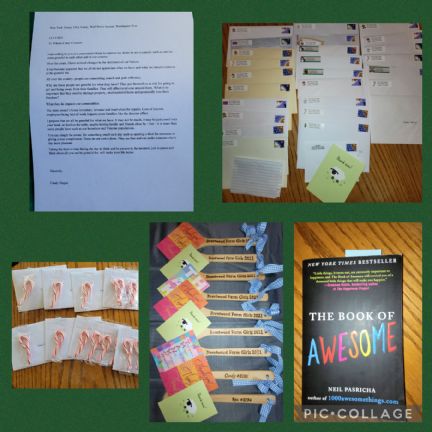
MaryJane, Farmgirl #1 Plowin' Thru ~ giving aprons a good wrap for 45 years and counting ~
 |
 |
|
|
MaryJane
Queen Bee
    
16781 Posts

MaryJane
Moscow
Idaho
USA
16781 Posts |
 Posted - Dec 22 2021 : 2:55:58 PM Posted - Dec 22 2021 : 2:55:58 PM

|
Candy Hogan (Tigger9777, #8283) has received a certificate of achievement in Farm Kitchen for earning an Intermediate Level Know Your Food Merit Badge!
“I made a pact with myself to eat 25% more organic food in my diet. In my food journal, I wrote down the names of 3 local CSA's with their phone numbers. Their websites did not list membership costs.
I looked on the internet to research high-fructose corn syrups and I can do most of it but my one weakness would be the soda. I have read the book called Omnivore's Dilemma by Michael Pollan.
It was good.”
.jpg?v 7752783)
MaryJane, Farmgirl #1 Plowin' Thru ~ giving aprons a good wrap for 45 years and counting ~
 |
 |
|
|
MaryJane
Queen Bee
    
16781 Posts

MaryJane
Moscow
Idaho
USA
16781 Posts |
 Posted - Dec 22 2021 : 4:30:21 PM Posted - Dec 22 2021 : 4:30:21 PM

|
Cindy Kinion (AussieChick, #6058) has received a certificate of achievement in Each Other for earning a Beginner Level Calligraphy Merit Badge!
“My mother first gave me a calligraphy pen when I was in high school. I hadn’t used it in a very long time, so I went out and bought three new ink cartridges and 2 new nibs for this merit badge. I was able to order the book Modern Calligraphy: Everything You Need to Know to get Started in Script Writing by Molly Suber Thorpe from Booktopia, and I also read The Calligraphy Studio: A Complete Step-by-step Guide to Calligraphy by Catrin Unwin. This book has script paper in the back where you can practice your pen strokes before getting started. I was able to try different angled strokes and follow the recommended order of strokes to achieve the desired effect. I also practiced Roman capitals and the Foundational Hand (or Roundhand).”
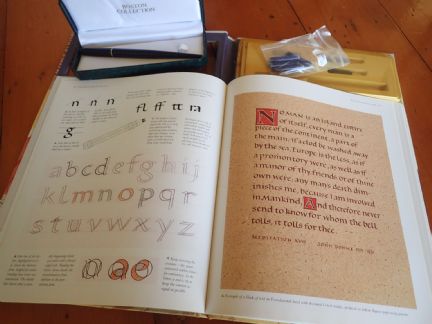
MaryJane, Farmgirl #1 Plowin' Thru ~ giving aprons a good wrap for 45 years and counting ~
 |
 |
|
|
MaryJane
Queen Bee
    
16781 Posts

MaryJane
Moscow
Idaho
USA
16781 Posts |
 Posted - Dec 22 2021 : 4:31:19 PM Posted - Dec 22 2021 : 4:31:19 PM

|
Cindy Kinion (AussieChick, #6058) has received a certificate of achievement in Farm Kitchen for earning a Beginner Level Forage for Food Merit Badge!
“I was able to investigate native edible plants in our area by taking a look at the Gabbinbar Aboriginal Garden Trail. Here, they grow all of the edible plants that are native to our area so that visitors can see the plants and easily identify them out in the wild. Here are some of the plants that I found:
Grass tree (xanthorrhoea latifolia). A plant that had many uses for Aborigines in the Toowoomba region. Uses included: the dry flower-stems were used as spears and fire-sticks; the flowers were a sweet nectar source; the bases of the leaves are sweet and nutty; a waterproof resin was collected from the leaf bases for attaching barbs in spears and stone axes to handles; and the tough leaves were used as knives to cut meat. When flowering, native bees love this plant. I have this one growing in my garden.
Quinine Bush (Petalostigma triloculare. This is a small tree. It has yellow flowers, bitter tasting bright orange hairy fruit, and medicinal bark. Aborigines used the fruits for toothache by placing the fruit into the mouth but not swallowing them. The bark was infused to make an antiseptic to treat fevers and wounds.
Midyim Berry (Austromyrtus dulcis). This small shrub grows naturally throughout the coastal areas of northern NSW and south-east QLD. The small white star flowers in Spring are followed by edible soft, sweet berries that are light purple with spots. Birds such as honeyeaters are attracted to this plant and the flower nectar feeds butterflies. Midyim berries were a favourite food for coastal Aboriginal people. A native plant mainly grown in coastal areas.
Peanut Tree (Sterculia quadrifida). This tree produces leathery, boat-shaped pods that ripen in Summer. The shiny, black seeds inside have a nutty ‘peanut’ flavour. Aborigines ate the nuts raw and roasted and used the fibrous bark to make nets.
Pigface (Corpabratus glaucescens). Aborigines ate the succulent green leaves, squeezed out the fleshy pink fruit that has a sweet, salty taste. Juice straight from the leaves can be used as a lotion to relieve the pain of burns and stings. A native plant of Australian coastal areas. I have this one growing in my garden and it makes a very pretty groundcover.
Devil’s Marbles (Eremophila debilis). This plant, like many plants has different common names. It has been called Johnny Apple and Winter Apple, and the name Devil’s Marbles probably comes from the botanical name ‘debilis’. It is a ground cover plant with small flowers which can be white, pink or purple depending where it grows. Look for the edible sweet fruits in winter. Local aborigines would certainly have eaten the fruits of this plant.
Blue Tongue (Melastoma malabathricum). This plant is found in many parts of Australia and Asia on the edges of forests. It is sometimes referred to as a native Rhododendron. The fruit is eaten by parrots. Aborigines ate this edible fruit. It is a tasty snack that will leave your mouth blue. A native plant found in many places including from north-east QLD to north-eastern NSW.
Yams (various species) & Warrigal greens (Tetragonia tetragoniodes). Two significant foods for Aboriginal peoples. Yams are the enlarged roots of several yam plant species. They are found in the wild all over Australia and are still a popular bush food. Sometimes the only sign of yams is a flowering vine that is growing up a tree. Traditionally, Aboriginal women used a digging stick to dig up yam roots. They can be eaten raw, or cooked in the ashes of a fire. Warrigal greens or wild spinach grows in many parts of Australia and was recorded by Early European visitors: firstly by Captain Cook in 1770, then by the First Fleet Europeans as a valuable source of ‘greens’ to avoid scurvy. Warrigal greens must be cooked and can be eaten in small quantities.
Lemon-scented Myrtle (Backhousia citriodora). The fresh lemon-scented leaves or dried leaves are popular in cooking bush-tucker foods; used as a refreshing tea; also in Asian cooking and are added to cleaning products, shampoos, soaps and body lotions. Crush a leaf and enjoy the smell. Local native plant to northern NSW and southern QLD.
Native hibiscus (Hibiscus heterophyllus) This plant once common from Brisbane to Toowoomba, was recorded by the botanist Allan Cunningham in 1824. It has a small flower like the large garden hibiscus. Traditional aboriginal uses included eating flower petals, and pounding the strong stem fibres to make string for dilly bags. The leaves and roots can be eaten and the flower buds made into a jam like rosella jam.
Bunya Pine (Arucaria bidwillii). Toowoomba was once on the important boinya-boinya trail from coastal SE Queensland to the Bunya Mountains where Aboriginal groups held a ‘Bunya Feast’ whenever the nuts were plentiful (approximately every 3 years). Groups from hundreds of kilometres away meet at special sites along the way for ceremonies, discussions, negotiations and trading of goods. The Bunya Pine is a totem for the local Jarowair people. Traditionally the nuts were ground and made into a paste which was eaten raw or roasted over hot coals to make bread and today many modern recipes have been created for bunya nut foods. I have roasted them and made them into a pesto.”
MaryJane, Farmgirl #1 Plowin' Thru ~ giving aprons a good wrap for 45 years and counting ~
 |
 |
|
|
MaryJane
Queen Bee
    
16781 Posts

MaryJane
Moscow
Idaho
USA
16781 Posts |
 Posted - Dec 22 2021 : 4:32:22 PM Posted - Dec 22 2021 : 4:32:22 PM

|
Cindy Kinion (AussieChick, #6058) has received a certificate of achievement in Garden Gate for earning a Beginner Level Water Management Merit Badge!
“With our hot Australian summers, it's vital to save water where possible. We've been very fortunate to have had fantastic rainfall in November, but this is not always the case and we can often head into summer in drought conditions with high fire danger. Water management is a constant issue in our area and there are often water restrictions placed on residents depending on the dam levels. The region’s combined drinking water dam levels for Somerset and Lockyer residents are sitting under 55%. Wivenhoe Dam is close to its lowest level since the Millennium Drought, sitting below 40%, so its important we all keep saving water where we can.
Our household depends solely on tank water. We have 2 x 25, 000L rainwater tanks on our house and a smaller 5000L water tank that we can pump water into for the garden. We have learned plenty of tricks to saving water while keeping our garden thriving. A soil meter is a cost-effective tool to help you avoid overwatering. Together with deep watering, this is a great indicator as to the moisture level in the soil. Watering deeply refers to watering in a manner which allows the soil to be soaked several inches (7-10 cm.) deep. Deep watering helps to make water more readily available to plants, and it allows for more efficient use of water in the event of prolonged periods without rain. Deep watering trees, shrubs, and other plants is also believed to aid in the development of strong roots. Heavy mulching also helps to keep the moisture in the soil after deep watering.
Other tips that we have learned for outdoor watering include: throw a handful of water crystals into the soil before you plant; poke a hole in old soft drink bottles, fill them with water, turn them upside down and push them into the soil to make a DIY self-watering system (this is great if we know we’re going to be away for a few days); set your mower a notch higher, to reduce evaporation and prevent the lawn scorching; if rain is on the way, hold off on watering and let mother nature do the work for you.
The best times for us to water our garden is in the morning and in the evening. You are best watering when it's not the heat of the day. You also don't want to water at night, as this can cause fungal issues in your lawn. Water for longer time periods, less frequently.
In Ravensbourne, there are two common soil types — you get black soil and red soil, which are greatly different from each other. Black soil is considered the tricky type to work with – it’s perfect for farming but it’s reactive and tends to have big range of movement when conditions shift from dry to wet. This is made from the rocks of lava and rich in clay. Black soils are highly moisture-retentive, extremely compact, and tenacious when wet, being substantially compressed to create deep, large cracks on drying and self-plowing. Black soils get very high fertility credits. Red soil, on the other hand, is clay soil. Red soil usually indicates extensive weathering and good drainage, but often needs nutrients and organic matter. The red colour is due to the oxidising of iron compounds ('rusting') in the soil.
Planting native plants can save you water because they are naturally adjusted to the local climate which means they require less water to survive. They can survive with the area's typical weather pattern. Several drought-hardy plants that grow well in our area are bottlebrushes, westringias, grass trees and banksias. I have attached a photo of my grass tree after flowering.”
MaryJane, Farmgirl #1 Plowin' Thru ~ giving aprons a good wrap for 45 years and counting ~
 |
 |
|
|
MaryJane
Queen Bee
    
16781 Posts

MaryJane
Moscow
Idaho
USA
16781 Posts |
 Posted - Dec 22 2021 : 4:33:21 PM Posted - Dec 22 2021 : 4:33:21 PM

|
Cindy Kinion (AussieChick, #6058) has received a certificate of achievement in Make It Easy for earning a Beginner Level Candlemaking Merit Badge!
“There are several types of candle wax readily available for making candles today: some natural, some synthetic, some a little bit of both, and each has its own particular qualities. Paraffin wax is one of the most versatile and common waxes used today. It comes in different melt points appropriate for many different applications, from votives to pillars to containers. Most of the commercially available candles you buy in stores today are made with paraffin. It is not universally embraced these days, however. Paraffin wax is a by-product of the crude oil refinement process, and green-minded folks often avoid it for this reason.
Soy wax is a new wax on the candle making scene, but it has taken a solid hold. With the demand for natural candles growing, soy wax was developed in the early 1990s as an alternative to petroleum-derived paraffin, and natural—but more expensive—beeswax. Like paraffin, soy wax comes in a variety of blends and melting points, though the most common soy waxes are container candle blends. Many soy waxes are made from 100% soybean oil. Others are blended with other vegetable oils (like coconut) and waxes (like palm and beeswax). There are also a number of paraffin/soy blends out there that capitalize on the benefits of both waxes. Note that as long as the blend is at least 51% soy, it is called a soy wax blend.
Beeswax is probably the oldest candle making wax; many would argue that it is also the best wax for candles. Beeswax candles were even found in the pyramids. Beeswax is produced by bees as a by-product of the honey-making process. The wax is excreted by the bees into "combs" to incubate their larvae. Since it is infused with honey during its creation, it has a naturally sweet fragrance which varies slightly depending on the flowers or plants the bees are feeding on. After it is harvested from the beehive, beeswax is melted and filtered several times. Candlemakers can purchase beeswax in blocks or slabs, like paraffin, in "pastilles" (little pellets) which melt very easily, or in pre-rolled sheets, which can be easily made into candles without any melting at all.
There is a wide variety of choices for scenting candles, but not all of them will align with your personal preferences. Some are commercially produced from chemicals, some come from plants, while others are based on essential oils. The origin of the scent may impact your choice to use it, especially if you're concerned about chemicals in your home environment. Typical sources of scenting candles include commercial candle making scents—these are in liquid form and are available from most stores that sell candle making supplies. The strength of the scent will vary from brand to brand and whether or not you have access to a full list of ingredients will depend on the manufacturer's willingness to provide this. Expect to use about 1 ounce of liquid scent to every 2 pounds of melted wax. Fragrance oils—these are 100% synthetic and are not specifically made for candles but usually still work for scenting them. The same issues as the commercial scents apply. Most are highly concentrated, so use of these should be sparing. Expect to use about 10-15 drops of fragrance oil per 1 pound of melted wax. Essential oils—these are produced naturally from plants such as herbs and flowers. Not all essential oils will work well with wax, so you may need to do a test first. Expect to use about 10-15 drops of essential oil per 1 pound of melted wax. Natural sources of scent—this covers such things as crushed or powdered plants, spices and herbs, finely ground zest, etc. Some work really well with melted wax, such as ground cinnamon, crushed lavender flowers or finely ground lemon zest. Others may not meld as well though, or can stop the wax from turning hard or prevent the wick from burning, so do your research first. Expect to use about 1 teaspoon of ground spice, herb or zest per 1 pound of wax.
Many candle companies sell liquid dyes that are specifically designed to be used with their products. Other all-purpose dyes will successfully colour almost any candle. The important thing is that you choose an appropriate dye for the type of wax you’re working with, otherwise, it may not blend properly. Powdered dyes and pigments, such as Rit Dye, can be useful for dyeing candles. Avoid ordinary liquid dyes like food colouring. When combined, the watery dye and oily wax will separate, producing an unsightly splotchy effect. To keep things simple, you can even use crayons. Since both the candle and the crayon are made of wax, they’ll blend like a dream.”
MaryJane, Farmgirl #1 Plowin' Thru ~ giving aprons a good wrap for 45 years and counting ~
 |
 |
|
|
MaryJane
Queen Bee
    
16781 Posts

MaryJane
Moscow
Idaho
USA
16781 Posts |
 Posted - Dec 22 2021 : 4:34:50 PM Posted - Dec 22 2021 : 4:34:50 PM

|
Cindy Kinion (AussieChick, #6058) has received a certificate of achievement in Garden Gate for earning a Beginner Level Bee Good to Your Mother Earth Merit Badge!
“I've been growing fruit trees and vegetables here in Ravensbourne since we first moved here in 2014. We have an orchard with mangoes, white mulberries, persimmons, lemons, oranges, figs, guavas, and avocados. It has taken most of the fruits trees about 5-6 years to start bearing fruit, so we have been finally seeing the results of our hard work in the past 2-3 years which is very exciting.
My vegetable garden was initially just in a patch of dirt that I had turned over with the rotary hoe. My husband later helped me to build 3 raised garden beds, which we covered with shade cloth to keep cool in the summer and to defend from destructive cockatoos who would eat everything.
We have a white picket fence around the garden to protect my herbs from the wallabies. Currently, I have thyme, rosemary, oregano, mint, aloe vera, sage, and tarragon growing in the herb section. I have a small lime tree and a passion fruit vine. In the raised beds, I have strawberries, rhubarb, basil, silverbeet and spinach. The only fertilisers I use are our neighbour’s cow manure and my friend, Kristy, makes worm tea from her worm farm. I have some companion flowers to help attract the beneficial insects. The shade cloth also helps prevent grasshoppers eating my plants. I have an old recipe for “Poor man’s Poison” weed killer (4 litres of vinegar, 1 cup salt, 1 tsp detergent mixed together in a spray bottle). I also find a thick layer of newspaper and then heavy mulching in the winter time prevents most weeds coming up in the summer. It also acts to keep in the moisture during our hot summers.
I couldn’t find Montrose: Life in the Garden at our library, but was able to get a copy via Amazon. This is a beautifully illustrated book. The seasons and plantings are quite different to what we would plant here in Australia, however, her vision for transforming her land into a series of gardens was inspiring.”
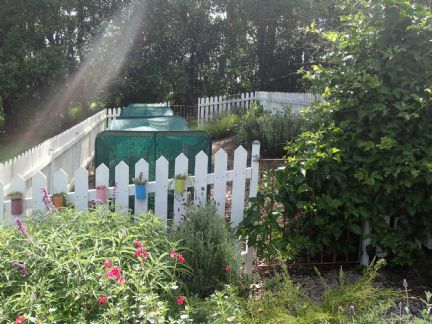
MaryJane, Farmgirl #1 Plowin' Thru ~ giving aprons a good wrap for 45 years and counting ~
 |
 |
|
|
MaryJane
Queen Bee
    
16781 Posts

MaryJane
Moscow
Idaho
USA
16781 Posts |
 Posted - Dec 22 2021 : 4:36:08 PM Posted - Dec 22 2021 : 4:36:08 PM

|
Cindy Kinion (AussieChick, #6058) has received a certificate of achievement in Garden Gate for earning an Intermediate Level Bee Good to Your Mother Earth Merit Badge!
“This is a great time of year to be out in the garden—the Australian summer. I have been gradually adding more native plants to our garden since we moved here to Ravensbourne. They are a lot less maintenance and usually have less water requirements which make them well suited to our environment in times of drought. So far, I have incorporated banksias, bottlebrushes, Kangaroo paw, grass trees, leptospermums, leucodendrons, eremophilas, Pigface, westringias, grevillias, lomandras, Goodenias, King orchids, Lilly pillys, Eucalypts, Ivory Curls, Illawara flame trees, and rice flowers. I love native flowers – they are so unique. I even chose them for our wedding bouquets 15 years ago. The bees and birds love the flowers. In addition to the natives, I have also added other flowers to attract the bees and birds including lavender, rosemary, citrus, passionfruit, salvias, zinnias, thyme, Russian sage, and I have even seen the birds taking a sample from my succulent and bromeliad flowers. We have 2 main watering points (bird baths that we keep topped up, especially in the hot months). We have our bird feeder on the fence where we put addition seed mix from time to time (the parrots love this!!).
We still have lawn, but 2 years ago we converted a section near the shed which was on a steep slope. We made a retaining wall and converted the entire top section to garden with the Pigface native groundcover and dietes (African wild iris). This made it much easier to maintain this section of the yard, and the groundcover has spread out so that I have very little weeding to do there.
I chose to collect some Xerochrysum bracteatum seeds, commonly known as the golden everlasting or strawflower. They are a native wildflower that often pops up in our lawn. The seeds are blown in the wind and they self-sow in our yard, so I thought they might be relatively easy to collect and plant in my garden. Interestingly enough, they weren’t as successful when I put the seeds in my garden. They would have more love and attention in my garden, but it seems they thrive on neglect out in the yard.
I have attached a photo of my native Kangaroo Paw which is out in flower at the moment. The birds love it!”
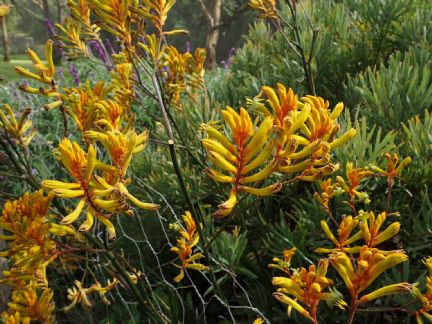
MaryJane, Farmgirl #1 Plowin' Thru ~ giving aprons a good wrap for 45 years and counting ~
 |
 |
|
|
MaryJane
Queen Bee
    
16781 Posts

MaryJane
Moscow
Idaho
USA
16781 Posts |
 Posted - Dec 22 2021 : 4:37:12 PM Posted - Dec 22 2021 : 4:37:12 PM

|
Cindy Kinion (AussieChick, #6058) has received a certificate of achievement in Cleaning Up for earning an Intermediate Level Going Green Merit Badge!
“Often people are not aware that cleaning products contain very harmful and dangerous chemicals. Exposure to these substances results in the build-up of harmful toxins in the body. Changing to greener cleaning methods is an inexpensive way to care for your environment and health. I have been using soap nuts for quite come time in my washing machine. Baking soda, vinegar, and tea tree oil are effective when it comes to cleaning your toilet and hand basin. I also use vinegar and Eucalyptus oil when I mop the floors. It leaves a very refreshing smell around the house too.
I also tried this new recipe for a bathroom scrub (for cleaning soap scum and residue on sinks and other kitchen, laundry and bathroom surfaces). Place 2 cups bi-carb soda in a bowl. Slowly add 1 cup liquid castile soap until the mixture becomes thick. Add in essential oils (10 drops peppermint and 12 drops of grapefruit oil), a little vinegar and thoroughly combine until a dense paste consistency is achieved. Spoon the mix into a glass jar.
Another great recipe that I tried was for a Dish Washing Liquid. Simply fill a recycled dishwashing bottle with 300ml liquid castile soap, 300ml purified water, 2 tbsp apple cider vinegar, 20 drops lemon essential oil and 16 drops tea tree oil.
For my soap recipe, I use 200ml purified water, 70g caustic soda, 500g coconut oil, 1 tbsp almond oil, 1 tbsp green clay, 20 drops peppermint essential oil, 20 drops lavender essential oil.
Oil of clove and orange essential oil are perfect in an anti-mould spray. For windows, I just use vinegar in water. For cleaning the oven, I only use baking soda.”
MaryJane, Farmgirl #1 Plowin' Thru ~ giving aprons a good wrap for 45 years and counting ~
 |
 |
|
|
MaryJane
Queen Bee
    
16781 Posts

MaryJane
Moscow
Idaho
USA
16781 Posts |
 Posted - Dec 22 2021 : 4:38:09 PM Posted - Dec 22 2021 : 4:38:09 PM

|
Cindy Kinion (AussieChick, #6058) has received a certificate of achievement in Farm Kitchen for earning an Intermediate Level Organic on a Budget Merit Badge!
“After achieving my “Organic on a Budget” beginner badge, I have continued on this journey of only buying organic fruits and vegetables. I buy most of them from the Organic Market grocery store or from the Farmers Market. Most of our local road-side stands sell organic produce as well, although they may not have the certification (this can be quite expensive for small farmers).
I have used all of the Gluten-Free Budget mix that I ordered from MaryJane. Now I have adapted the Bakeover crust recipe in MaryJane’s Ideabook to make my own gluten-free crust. I find the Bakeovers are an easy meal to throw together during the week if I am arriving home late from work. There is very little that I have to buy from the inner section of the grocery store. The majority of my groceries are now from the perimeter where fresh, non-processed ingredients are found. I do believe it has certainly made a difference to our grocery budget. At this stage, I would estimate that we are saving, on average, about $50-$70 every 2 weeks.”
MaryJane, Farmgirl #1 Plowin' Thru ~ giving aprons a good wrap for 45 years and counting ~
 |
 |
|
|
MaryJane
Queen Bee
    
16781 Posts

MaryJane
Moscow
Idaho
USA
16781 Posts |
 Posted - Dec 22 2021 : 4:39:36 PM Posted - Dec 22 2021 : 4:39:36 PM

|
Cindy Kinion (AussieChick, #6058) has received a certificate of achievement in Garden Gate for earning an Intermediate Level Grow Where You're Planted Merit Badge!
“I researched 5 native Australian grasses/ground covers. I have photographed each one in my garden and shared my presentation on the Farmgirl Connection Chatroom under Merit Badge Chit Chat.
Kalbarri Carpet (Eremophila glabra). A lovely ground cover shrub, with dense soft grey foliage and beautifully contrasting yellow-gold flowers. Main flowering is in spring and summer, with spot flowers in winter and autumn, and birds and other nectar feeders love them. It has a one to two metre spread, and is drought and frost tolerant. These plants are often known as poverty bushes because of their unpalatability to stock and their ability to persist under conditions that other more desirable plants cannot. They have also been known as the emu bush because emus will feed on the fleshy fruits of some species. Eremophila have played an important role in traditional Aboriginal medicine and culture, and many have the potential for pharmaceutical uses.
Pigface (Corpabratus glaucescens). This plant brightens up a garden space. Aborigines ate the succulent green leaves, squeezed out the fleshy pink fruit that has a sweet, salty taste. Juice straight from the leaves can be used as a lotion to relieve the pain of burns and stings. A native plant of Australian coastal areas including Botany Bay.
Prostate Hop Goodenia (Goodenia ovata). This is a very tough ground covering plant that features buttercup yellow flowers over an extended period in spring and summer and bright green fleshy leaves. This native is great when used as a groundcover, and is hardy and adaptable. The butterflies, bees and native birds love it.
Green Mat Rush (Lomandra hystrix). The plant is often used for revegetation of watercourses and erosion control. The starchy, fleshy bases of the leaves are edible, tasting of raw peas. Even when the roots are exposed it will cling tenaciously in poor soils.
Dwarf Coastal Rosemary (Westringia fruticosa). This is a very compact form and is very adaptable to most situations. Its grey-green foliage and small white flowers are attractive to butterflies and harmless native bees. This is an extremely tough ground cover that is great for stabilizing erosion prone banks or just generally wherever a dense growing and weed deterring ground cover is required.”
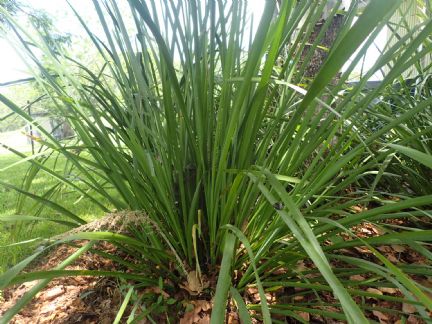
MaryJane, Farmgirl #1 Plowin' Thru ~ giving aprons a good wrap for 45 years and counting ~
 |
 |
|
|
MaryJane
Queen Bee
    
16781 Posts

MaryJane
Moscow
Idaho
USA
16781 Posts |
 Posted - Dec 22 2021 : 4:41:06 PM Posted - Dec 22 2021 : 4:41:06 PM

|
Cindy Kinion (AussieChick, #6058) has received a certificate of achievement in Each Other for earning an Expert Level Families Forever Merit Badge!
“This time of year is perfect for getting out into the great outdoors. We are enjoying our warm summer months, and what better way to spend a summery Saturday than water-skiing with our friends Wayne & Marie (and their children Jalisa & Scott). It was Marie’s Dad who first taught me to water-ski. Whilst I’m still not very good at it, I am getting better and we really enjoy the company of friends. We spent the day at Maroon Dam and everyone took something to contribute to a picnic lunch.
Mick & I have also been really enjoying getting outdoors looking for geocaches. It’s somewhat like orienteering, but with GPS coordinates. You look for hidden containers that have a log to sign and then they may also have little trinkets or “travel bugs” that can be moved around. Geocaching is a world-wide game. We enjoy it because it can take you to some unusual spots that you may otherwise have missed, and often there is some interesting information to learn about where the geocache has been placed. My niece, Hannah, has come along with us on a few geocaching adventures. It's a great activity for children to enjoy.”

MaryJane, Farmgirl #1 Plowin' Thru ~ giving aprons a good wrap for 45 years and counting ~
 |
 |
|
|
MaryJane
Queen Bee
    
16781 Posts

MaryJane
Moscow
Idaho
USA
16781 Posts |
 Posted - Dec 29 2021 : 10:25:57 AM Posted - Dec 29 2021 : 10:25:57 AM

|
Candy Hogan (Tigger9777, #8283) has received a certificate of achievement in Farm Kitchen for earning an Expert Level Know Your Food Merit Badge!
“I shared information on the Farmgirl Connection about local farmer's markets, ideas to consider avoiding pesticides, synthetic ingredients, and local organizations that help you avoid those ingredients.
I went to the local farmers market to try and increase my organic diet. I talked to two local food growers and I was impressed with the quality of vegetables and fruits they had for sale.
I advertised a free evening class on zoom to my Brentwood Farm Girl Chapter on how to change your diet and change your life. I've included photos of my agenda for that class and my local CSA's. I read the book In Defense of Food by Michael Pollan.”
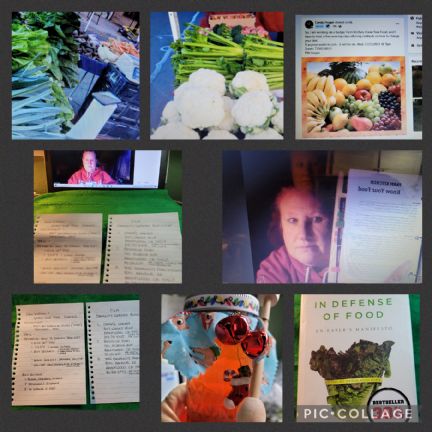
MaryJane, Farmgirl #1 Plowin' Thru ~ giving aprons a good wrap for 45 years and counting ~
 |
 |
|
|
MaryJane
Queen Bee
    
16781 Posts

MaryJane
Moscow
Idaho
USA
16781 Posts |
 Posted - Dec 29 2021 : 10:27:09 AM Posted - Dec 29 2021 : 10:27:09 AM

|
Candy Hogan (Tigger9777, #8283) has received a certificate of achievement in Stitching & Crafting for earning an Intermediate Level Embroidery Merit Badge!
“I embroidered my own set of days of the week tea towels. It took me 23 days to finish. It turned out nice.”
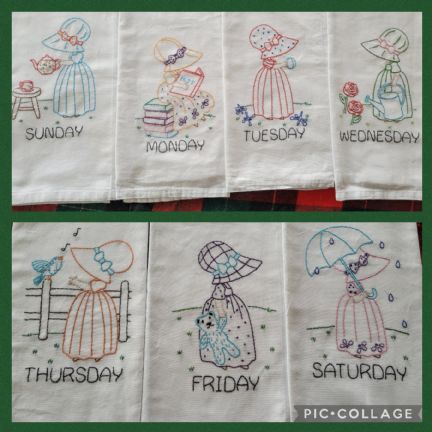
MaryJane, Farmgirl #1 Plowin' Thru ~ giving aprons a good wrap for 45 years and counting ~
 |
 |
|
|
MaryJane
Queen Bee
    
16781 Posts

MaryJane
Moscow
Idaho
USA
16781 Posts |
 Posted - Dec 29 2021 : 10:28:18 AM Posted - Dec 29 2021 : 10:28:18 AM

|
Candy Hogan (Tigger9777, #8283) has received a certificate of achievement in Farm Kitchen for earning an Expert Level Recipes Merit Badge!
“I waited a whole year before completing the expert level badge because I wanted to make sure to get pictures of some of our more traditional recipes. Every year we make 50 pounds of homemade fudge. This recipe is from my grandmother's sister, Maude, who worked for See's Candies in the 1920's, and they don't make this original recipe anymore. We only do it at Christmas time and everybody waits for it because it is so special. Each year we also make a turkey and homemade bread.
The next picture is of a macaroni salad that was made by my grandmother and passed down for 4 generations now. We make lemon cookies and homemade butter pats. The butter will keep in the refrigerator for up to 2 weeks. We always make chocolate chip cookies for Santa each year. Another cookie recipe we only do at Christmas time is a butter cookie recipe from the 1950s. We also do an Orange jello pineapple salad for each holiday.”
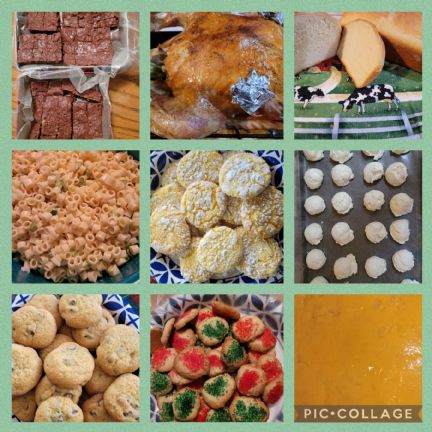
MaryJane, Farmgirl #1 Plowin' Thru ~ giving aprons a good wrap for 45 years and counting ~
 |
 |
|
|
MaryJane
Queen Bee
    
16781 Posts

MaryJane
Moscow
Idaho
USA
16781 Posts |
 Posted - Dec 29 2021 : 12:50:31 PM Posted - Dec 29 2021 : 12:50:31 PM

|
Cindy Kinion (AussieChick, #6058) has received a certificate of achievement in Cleaning Up for earning a Beginner Level Home Insulation Merit Badge!
“There are several different types of insulation, including loose-fill and blown-in insulation, batt & roll insulation, reflective insulation and radiant barriers, spray foam and foam-in-place insulation.
We have Earthwool batts in the walls and roof of our house, and we are in the process of attaching them under the floorboards as well. The thermal properties of Earthwool act as a barrier to the outside elements to limit heat loss in winter and heat gain in summer through the walls, ceiling and floor. Earthwool will also absorb sound transfer in external and internal walls, and it has inherent fire performance, which means the insulation is non-combustible. It is made using up to 80% recycled glass which makes it a sustainable product.
With regards to our window glass, when we first moved into our house, we had frosted glass in our casement windows. This was very inefficient because many were cracked, allowing air leakage. We have since replaced all of the glass in our casements with a product called OptiLam. It is a tinted laminated glass which assists in the reduction of solar heat gain, in turn making a home cooler during the warmer months. Additional benefits include improved safety and security and reduced noise and fading. We have also added traditional window hoods which help to shade the western side of our house from hot afternoon sun.
Our power company, Energex, offers rebates for solar energy, certain air conditioner purchases, and hot water systems, but I couldn’t see that they offered any rebate or credit for insulation. You can, however, save on your energy bills by using insulation. Insulation is as effective keeping the heat in, as it is keeping the heat out. On average, households with ceiling, wall and under floor insulation can save around $450 per year on energy bills.
I have shared what I have learned on the Farmgirl Chatroom under merit badge chit chat.”
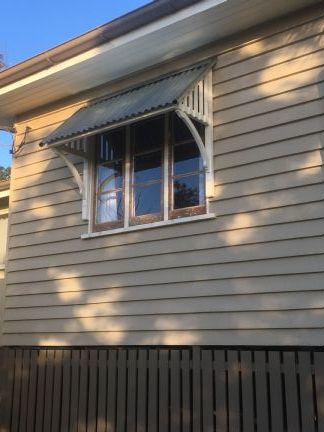
MaryJane, Farmgirl #1 Plowin' Thru ~ giving aprons a good wrap for 45 years and counting ~
 |
 |
|
|
MaryJane
Queen Bee
    
16781 Posts

MaryJane
Moscow
Idaho
USA
16781 Posts |
 Posted - Dec 29 2021 : 12:51:42 PM Posted - Dec 29 2021 : 12:51:42 PM

|
Cindy Kinion (AussieChick, #6058) has received a certificate of achievement in Cleaning Up for earning a Beginner Level Green Energy Merit Badge!
“The three major categories of energy for electricity generation are fossil fuels (coal, natural gas, and petroleum), nuclear energy, and renewable energy sources. Most electricity is generated with steam turbines using fossil fuels, nuclear, biomass, geothermal, and solar-thermal energy. Unfortunately, we still rely very heavily on energy from nonrenewable sources, eg. petroleum, hydrocarbon gas liquids, natural gas, coal, nuclear energy. These energy sources are called nonrenewable because their supplies are limited to the amounts that we can mine or extract from the earth. Coal, natural gas, and petroleum formed over thousands of years from the buried remains of ancient sea plants and animals that lived millions of years ago. That is why we also call those energy sources fossil fuels.”
MaryJane, Farmgirl #1 Plowin' Thru ~ giving aprons a good wrap for 45 years and counting ~
 |
 |
|
|
MaryJane
Queen Bee
    
16781 Posts

MaryJane
Moscow
Idaho
USA
16781 Posts |
 Posted - Dec 29 2021 : 12:52:47 PM Posted - Dec 29 2021 : 12:52:47 PM

|
Cindy Kinion (AussieChick, #6058) has received a certificate of achievement in Each Other for earning a Beginner Level Differing Abilities Merit Badge!
“Disability can be defined in several different ways, depending on the context that the word is used. However, disability is often defined as any limitation, restriction or impairment, which restricts everyday activities and has lasted or is likely to last for at least six months. Disabilities can be very different person to person. They can be physical, intellectual, a mental illness, or sensory. They can be temporary or permanent, and can be there from birth or occur during a person’s lifetime.
• Around 6.8 million Australians (40 percent) aged 18 years and over report having a disability or long-term health condition.
• Most people with disabilities (87%) are restricted in carrying out at least one everyday activity, such as self-care, mobility or communication.
• The likelihood of having a disability increases as people age. For example, 7% of children aged under 15 years, 15 percent of people aged 15 to 64 years and over half (53%) of people aged 65 years and over report having some form of disability.
• In 2009, 290,000 children aged 0 to 14 years reported having a disability. Over half (57% had a profound or severe disability and almost one in five (18%) had a moderate or mild disability.
For about 3 in 4 (77%) people with disability, their main form of disability (that is, their main condition or the one causing the most problems) is physical. This includes diseases of the:
• musculoskeletal system and connective tissue (30%), such as back problems and arthritis
• ear and mastoid process (8.4%), such as hearing loss and tinnitus
• circulatory system (6.3%), such as heart disease and stroke
• nervous system (6.7%), such as cerebral palsy and multiple sclerosis (ABS 2019b).
Of the 1 in 8 people with disability who are disabled as a result of an accident or injury, the incident most commonly happened on the road (30%) or at work (29%), followed by at home (18%) and sporting venues (7.6%).
For the remaining 1 in 4 (23%), their main form of disability is mental or behavioural, including:
• intellectual and developmental (6.5%), such as intellectual disability and autism
• mood affective (3.8%), such as depression
• dementia and Alzheimer disease (2.6%) (ABS 2019a, 2019b).
Here are some additional facts that I learned about the prevalence of disabilities in Australia. Every week, five Australians sustain a spinal cord injury. Every week 10–15 Australians sustain a severe brain injury. Every 13 hrs, a child is born with cerebral palsy. Approximately 1 in 1,100 babies are born each year with Down Syndrome. Every 7 hrs, a child is diagnosed with an autism spectrum disorder. Every 2 hrs, a child is diagnosed with an intellectual disability. One in six Australians are affected by hearing loss.”
MaryJane, Farmgirl #1 Plowin' Thru ~ giving aprons a good wrap for 45 years and counting ~
 |
 |
|
|
MaryJane
Queen Bee
    
16781 Posts

MaryJane
Moscow
Idaho
USA
16781 Posts |
 Posted - Dec 29 2021 : 12:55:36 PM Posted - Dec 29 2021 : 12:55:36 PM

|
Cindy Kinion (AussieChick, #6058) has received a certificate of achievement in Stitching & Crafting for earning a Beginner Level Aprons Merit Badge!
“Whilst I have a few aprons in the kitchen that I like to wear when I'm baking, I had never made one myself. My mum gave me the use of a very old pattern book called "Pinnies 'n' Things" by Enid Gilchrist. I can't see a date on it, but the fact that it only cost 50 cents makes me think it's pretty old. Anyway, there are some simple old-fashioned apron patterns to follow and I chose to make a half apron.
I used a fabric featuring native Australian banksia flowers. The colours also looked a little Christmasy—perfect for this time of year. I added a matching waistband/strings.”
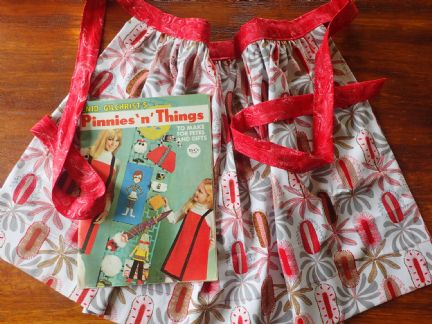
MaryJane, Farmgirl #1 Plowin' Thru ~ giving aprons a good wrap for 45 years and counting ~
 |
 |
|
|
MaryJane
Queen Bee
    
16781 Posts

MaryJane
Moscow
Idaho
USA
16781 Posts |
 Posted - Dec 29 2021 : 12:56:56 PM Posted - Dec 29 2021 : 12:56:56 PM

|
Cindy Kinion (AussieChick, #6058) has received a certificate of achievement in Stitching & Crafting for earning a Beginner Level Dyeing for Color Merit Badge!
“From Ancient Egypt to the modern day—for over 4000 years mankind has been brightening up clothing with natural and synthetic dyes. Throughout the ages adding individuality to clothing with colour has been used to denote gender, status, and allegiance. It started with natural mineral and plant dyes, but with the discovery of synthetic dyes came a plethora of colour choices.
Archaeologists who have studied the earliest surviving coloured fabrics and important ancient manuscripts have concluded that there were three types of natural dyes: vegetable or plant dyes, mineral dyes, and insect or animal dyes.
Mineral dyes came from minerals found on the earth’s surface and in mines. Hematite for red, limonite for yellow, and lazurite for blue were used to provide the necessary colours for textiles. By scratching the rocks’ surface, a powder was created, which after solving with water or oil, was ready to use. Because they were inorganic in nature, and do not degrade over time like plant or animal dyes, they can survive for years if sheltered.
Another type of natural dyes came from animals—such as insects, lichens, and shellfish. The most well-known insects that have been used during the ancient times are kermes and cochineal, which produced scarlet and crimson red accordingly.
Vegetable dyes are made from leaves, bark or roots from trees and plants. They were the most used in antiquity as they were the easiest to find and develop. The most common dyes were made of madder for red, saffron and safflower for yellow, and indigo for blue and blueish purple. Items dyed in indigo were considered luxurious, as they were hard to find.
This all changed in the mid-19th century, with the invention of a synthetic dye. Dyed garments became more affordable, which coincided with the Industrial Revolution and the rise of the middle class. In 1856, William Henry Perkins was searching for a cure for malaria when he discovered the first synthetic dye. Mauve in colour, this aniline dye would be the beginning of a new era in the history of fabric dying. Throughout the mid-to-late 19th century scientists around the world began to develop colours for dying fabrics from chemicals. Nowadays, almost every garment has been dyed with synthetic dyes, with the exception of communities in North America, Asia, Africa, and the Scottish Highlands. One of the most hazardous substances in the textile industry is chromium. Repeated exposure can lead to skin rashes, respiratory problems, kidney and liver damage, and on continuous exposure it may lead to lung cancer also.
Recommended safety information when using fabric dyes at home includes:-
• Wear an approved dust mask when handling powders so you don't inhale dye or chemical dust. Inhaling powders and dusts of any kind is not good for you. Inhaling is the main way these type of chemicals can get into your body. If you work with dyes and chemicals for a living, have allergies or chemical sensitivities, upgrade yourself to a good deluxe rubber respirator.
• Wipe up areas where you have been using powdered dyes or chemicals with a damp old towel afterwards, to pick up any stray powder so it won't get into or on stuff. Wipe up liquid spills immediately, because after they dry up, they can become airborne.
• If there is any chance of getting the dyes or chemicals in your eyes, wear protective goggles.
• Wear rubber gloves so that you don't wreck your skin or absorb stuff through your skin (though most molecules are too large to actually absorb) or look like some weird tie-dyed creature.
• Provide adequate ventilation if fumes or powder dusts are present. This means cross ventilation, preferably with an exhaust fan. You can also put a box fan in one window, pointed to the outside to suck out room air, and open another window opposite for the fresh air to come in and replace it.
• Don't breathe fumes. Dust masks don't help with fumes. deluxe rubber respirators will keep you from breathing dusts, mists and vapors with the proper filters.
• Don't use cooking or eating utensils to prepare dyes, chemicals and other craft products that are not intended for human consumption. Get a used microwave, if you are using one for your craft, to use as a dedicated microwave just for your craft.
COFFEE-STAINING:- I chose to use a natural dye with far less safety considerations. Yes, I chose to dye using coffee.
Start by washing your fabric (for fabric that's already laundered, soak your material so it's very wet).
Brew a large pot of coffee or mix a pitcher of instant coffee. Stronger coffee or a darker roast will produce darker dye. The amount of time you leave your fabric in the coffee will also affect the colour, but the strength and roast really make a difference. Place the wet fabric or clothing in a large bowl. To achieve an even colouring, it helps to have enough room that the material isn't all bunched up. Pour the hot coffee over the fabric and stir it with a wooden spoon. You want the coffee dye to evenly soak through the fabric and stirring helps that happen. This also helps open up the fabric so you don't have areas that cling together. Gently wring out the fabric. Fill a bowl with hot water and a few tablespoons of vinegar (or more for a large piece of fabric or clothing). Place the dyed fabric in the water to rinse and soak for a few minutes. The vinegar helps set the dye. After about 10 minutes or so, remove the fabric and thoroughly rinse it under running water to remove any excess coffee dye. When the water runs clear it's all ready for the final step. To finish setting the colour in your fabric, let the fabric dry and iron it. Instead of air-drying, you can also toss it in a dryer on the hottest setting that is safe for your fabric.
I made 2 pillow cases. The colour was quite light, so next time I would use a darker roast.”

MaryJane, Farmgirl #1 Plowin' Thru ~ giving aprons a good wrap for 45 years and counting ~
 |
 |
|
|
MaryJane
Queen Bee
    
16781 Posts

MaryJane
Moscow
Idaho
USA
16781 Posts |
 Posted - Dec 29 2021 : 12:58:30 PM Posted - Dec 29 2021 : 12:58:30 PM

|
Cindy Kinion (AussieChick, #6058) has received a certificate of achievement in Make It Easy for earning a Beginner Level Grease Chicks Merit Badge!
“I have a 1997 Ford Laser and prior to that I had a 1975 Volkswagen Beetle. I love older cars and I like that the maintenance is easier. My husband has a new Ford Ranger Ute and there is a lot more computerized instruments that require specialized servicing. I am able to perform regular checks of my engine cooling system and coolant level, engine oil level, windscreen washer fluid, brake/clutch fluid level, and tire pressure.
I have maintained a log book of mileage and fuel usage since I first took ownership of the car in April 2012. In this log book, I also document when I get the car serviced, any parts replaced, and when I purchase new tires.”
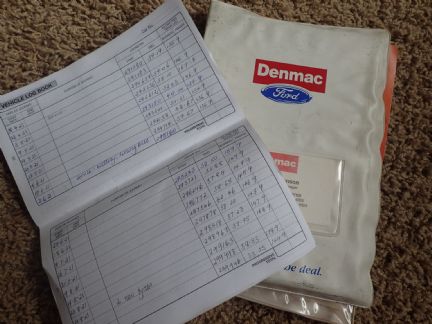
MaryJane, Farmgirl #1 Plowin' Thru ~ giving aprons a good wrap for 45 years and counting ~
 |
 |
|
|
MaryJane
Queen Bee
    
16781 Posts

MaryJane
Moscow
Idaho
USA
16781 Posts |
 Posted - Dec 29 2021 : 12:59:19 PM Posted - Dec 29 2021 : 12:59:19 PM

|
Cindy Kinion (AussieChick, #6058) has received a certificate of achievement in Make It Easy for earning an Intermediate Level Grease Chicks Merit Badge!
“I am able to change the oil in my car and my husband has also showed me how to change the oil filter. The oil is changed approximately every 5000km and the filter is changed approximately every 10,000km. We are able to take our used oil to the Ravensbourne Transfer Station where they have an oil dumping point free of charge to local residents.
I have also learned how to jump start the car if the battery is flat. I have jumper leads in the boot of the car and I have learned which end of the jumper lead goes to which terminal on the battery, ensuring that the clamps don’t touch.
I can also change the windscreen wiper blades.”
MaryJane, Farmgirl #1 Plowin' Thru ~ giving aprons a good wrap for 45 years and counting ~
 |
 |
|
|
MaryJane
Queen Bee
    
16781 Posts

MaryJane
Moscow
Idaho
USA
16781 Posts |
 Posted - Dec 29 2021 : 1:00:19 PM Posted - Dec 29 2021 : 1:00:19 PM

|
Cindy Kinion (AussieChick, #6058) has received a certificate of achievement in Garden Gate for earning an Intermediate Level Water Management Merit Badge!
“Black soil is made from the rocks of lava and rich in clay. Black soils are highly moisture-retentive, extremely compact, and tenacious when wet, being substantially compressed to create deep, large cracks on drying and self-plowing. It has high amounts of lime, iron, magnesium and generally low quantities of phosphorus, nitrogen and organic matter. It can have up to 50% clay content and therefore is highly retentive of water.
Red soil, on the other hand, is clay soil. Red soil usually indicates extensive weathering and good drainage, but often needs nutrients and organic matter.
You can improve your soil quality by reducing inversion tillage and soil traffic; working in 3 to 4 inches of well-rotted manure or compost; using cover crops; reducing pesticide use and providing habitat for beneficial organisms; rotating crops; and managing nutrients.
Mulch can reduce evaporation from soil by up to 70%. Not only do mulches conserve water and reduce the need for irrigation, they also moderate soil temperature, inhibit weed growth and, over time, improve the soil structure and health of plants. Mulch is an essential component of maintaining a water efficient garden.
I use sugar cane mulch on my vegetables and herbs. This type of mulch breaks down quickly, helps to retain moisture and encourages soil organisms.
I find that my native gardens tend to do better with hoop pine mulch. Hoop Pine Bark is a traditional landscapers favourite product for heavily wind swept areas or steep embankments. It is an ideal product that will keep the weeds at bay, retain moisture and eventually break down and add to your nutrient rich soil.
On the odd occasion that hoop pine mulch is not available, I have used tea tree mulch. It improves soil structure, insulates against extreme hot or cold temperatures, and encourages earthworms Tea Tree Mulch breaks down slowly, enriching the soil through composting.
Ground covers can be useful in retaining soil moisture and also in cooling soil temperatures. Grevillea “Bronze Rambler”, Poorinda “Royal Mantle”, dwarf forms of woolly Grevilleas (G. Lanigera), scaevolas, lomandras, dianellas, day lilies, liriopes, and star jasmine are some good choices in our area.”
MaryJane, Farmgirl #1 Plowin' Thru ~ giving aprons a good wrap for 45 years and counting ~
 |
 |
|
|
MaryJane
Queen Bee
    
16781 Posts

MaryJane
Moscow
Idaho
USA
16781 Posts |
 Posted - Dec 29 2021 : 1:02:32 PM Posted - Dec 29 2021 : 1:02:32 PM

|
Cindy Kinion (AussieChick, #6058) has received a certificate of achievement in Garden Gate for earning an Intermediate Level The Secret Life of Bees Merit Badge!
“I thoroughly enjoyed reading Candace Savage’s book Nature’s Little Wonders. Bees are certainly nature’s little wonders!
Here are 4 main differences between raw honey and processed honey.
• Raw honey isn’t processed.
Raw honey undergoes minimal processing. Gentle low-temperature warming allows it to flow for bottling and a light straining is undertaken to remove larger particles such as leaves and non-honey debris. Regular commercially produced honey undergoes processing, including pasteurisation (heating the honey to very high temperatures) that destroys yeast found in honey, and ultrafiltration to prevent crystallisation and increase shelf life.
• Processed honey is not always honey.
In simple terms, raw honey is extracted from the beehive, strained and poured straight into the bottle– so what you get is just from the bees collected. As mentioned, regular honey is often heavily processed with sugars, (including corn and glucose syrups) added to increase the volume of honey, reduce its cost and extend its shelf-life. A recent investigation into commercial honey in Australia revealed almost 50% of honey tested was adulterated; and, 12 of the 28 samples tested were not 100 percent pure honey.
• Most Processed Honey Doesn’t Contain Any Pollen
Bee pollen is collected with nectar by honey bees. While we often focus on honey, bee pollen has been shown to be “nutritious, containing over 250 substances, including vitamins, amino acids, essential fatty acids, micronutrients and antioxidants”. And, according to the German Federal Ministry of Health, bee pollen is recognised as medicine and has been linked to remarkable health benefits, including reducing inflammation. Unfortunately, pasteurisation and other processing methods like ultrafiltration used in regular, commercially produced honey, may remove bee pollen.
• Raw Honey Is More Nutritious.
Raw honey has been shown to contain “several physiologically important amino acids, including all nine essential amino acids and all nonessential amino acids except for glutamine and asparagine”. In addition, 31 different minerals were detected, “including all of the major minerals, such as calcium, phosphorus, potassium, sulphur, sodium, chlorine, and magnesium.” Many studies link these antioxidants with health benefits, including reduced inflammation and a lower risk of heart disease and certain cancers. Unfortunately, commercially produced honey, i.e. honey that is heavily processed, removes beneficial nutrients like pollen, enzymes and antioxidants.
We are fortunate to have 3 local honey vendors - Cabarlah Grove, Bliss Buzz Honey (Crows Nest) & Geham Honey. We also had the pleasure of visiting 2 raw honey vendors during our trip to Tasmania (Melita Pure Honey & Wild Hives Raw Honey).”
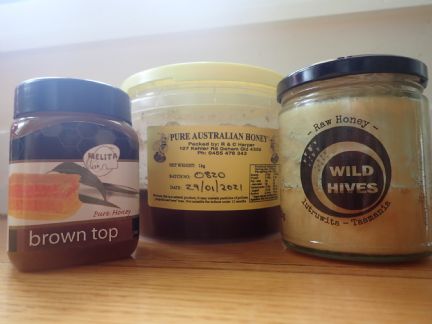
MaryJane, Farmgirl #1 Plowin' Thru ~ giving aprons a good wrap for 45 years and counting ~
 |
 |
|
|
MaryJane
Queen Bee
    
16781 Posts

MaryJane
Moscow
Idaho
USA
16781 Posts |
 Posted - Dec 29 2021 : 1:04:01 PM Posted - Dec 29 2021 : 1:04:01 PM

|
Cindy Kinion (AussieChick, #6058) has received a certificate of achievement in Outpost for earning an Intermediate Level Rocks and Minerals Merit Badge!
“Rather than visit a museum, we visited a rock display of another kind. Whilst in South Australia in November, we travelled to the Flinders Ranges and drove the 20-kilometre self-guided Brachina Gorge Geological Trail. The trail passes through 130 million years of earth history. Trail signage provides an insight into past climates, the formation of the ranges and the evolution of early life forms.
Sandy and silty sediments derived from erosion of older rocks of the Gawler Craton in the hinterland to the west, and island masses of this basement rock rising from an undersea ridge over 200 km to the east, were deposited into an extensive marine basin called the Adelaide Geosyncline in which the seafloor was slowly subsiding along a series of elongated north-south step or graben faults. During the 300 million years of continuing but intermittent subsidence of the basin floor, a thick pile of sediment accumulated in the geosyncline. This sequence was then compressed and hardened by deep burial and later folded into a high mountain range by a new regime of earth movements. Subsequent erosion has reduced these highlands to their present form and deposited huge amounts of sediment to the east into younger sedimentary basins formed by later crustal down warping. Excellent exposures of rocks deposited in the Adelaide Geosyncline between about 650 and 500 million years ago can be seen in Brachina Gorge, particularly on the southern wall.
A series of track-side signs have been placed in the approximate position of where the boundary between a younger (overlying) sedimentary bed and an older (underlying) bed crosses the track. Some of the sites included Wilkawillina Limestone, Bonney Sandstone, Rawnsley Quartzite, Enorama Shale. Being out amongst nature was a fascinating way to appreciate the various rock formations.
I have also started my little collection of rocks. Note: the blue one was a Christmas gift from my 2-year-old niece. She painted rocks and gave them to all the relatives for Christmas, so I have added it to my collection.”
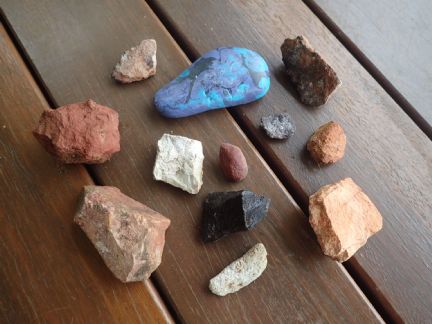
MaryJane, Farmgirl #1 Plowin' Thru ~ giving aprons a good wrap for 45 years and counting ~
 |
 |
|
Merit Badge Awardees - Woo-hoo Sisters!:  Farmgirl Sisterhood Merit Badge Awardees Farmgirl Sisterhood Merit Badge Awardees  |
|
|
|